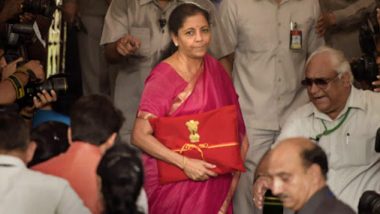New Delhi, January 31: India's economic situation is going through its toughest phase in the last three decades. With liquidity crunch, joblessness, slow growth, shrinking manufacturing sector, aggravated agrarian woes and decline in purchasing power, Finance Minister Nirmala Sitharaman has a tough task ahead to increase the momentum of the Indian economy. The Union Budget 2020-21 is all about expectations of nation where the issues of common people and the corporate sector, both need to be addressed.
Before moving into the predictions and expectations from Nirmala Sitharaman's 'Bahi Khata', let us first look at the current economic situation of the country. The gross domestic product growth is at 4.5 percent, which is a 26 quarters' low. Apart from this, India's inflation rate accelerated to a whopping 7.35 percent in December 2019, with food inflation surging at 14.12 percent. Auto sector's production too registered a de-growth of (-) 13.07 percent in April-December 2019 and unemployment rate among youth soared at 22.5 percent (age 15-29 years), which is highest in the last 45 years. Similar are the situations in other sectors. Union Budget 2020: Nobel Laureate Abhijit Banerjee Advises Centre to Reform Tax, Says 'Reintroduce Wealth Tax, Re-Finance Banking Sector'.
With Union Budget 2020 to be presented by the Union Finance Minister on February 1, in the Parliament, all eyes would be on the Sitharaman, who is trying her best to deal with the decline in the Indian economy. The Finance Ministry had already prepared the Budget and the draft is in the printing stage.
Here's What Each Sector Is Expecting:
Agriculture and Farming:
Considering that India is an agrarian-dominant nation and the farmers are in a dilapidated state, the sector needs massive reforms. The year 2019 also saw incessant rains, floods in may states destroy crops which led to depreciative value of crops being put in place, the hike in minimum selling price of agrarian goods is what the farmers are expecting.
Adding to this, loan waivers, adequate food storage facilities and ease in acquiring loans from banks are the other major demands. Apart from this, compensations for the crop failure and decrease in the fertilisers' rate are also on farmers wish list. These expectations come despite the fact that Finance Minister Sitharaman had hiked the agriculture budget for FY 2019-20 by over 78 per cent to Rs 1.39 lakh crore, out of which Rs 75,000 crore were for the flagship scheme PM-KISAN.
Income Tax and GST:
This is one area in which every Indian is expecting a rejig. As per sources, the Union government is mulling to rejig the IT slab and create new ones for ease of taxpayers. Reports suggest there will be no tax on first Rs 2.5 lakh, 5 percent on income between Rs 2.5 and 7 lakh, 10 percent on income between Rs 7 lakh and Rs 10 lakh, 20 percent on earnings between Rs 10 lakh and Rs 20 lakh. For income bracket from Rs 20 lakh to Rs 10 crore, the tax proposed is 30 percent. The government may impose 35 percent tax if the income exceeds Rs 10 crore. Union Budget 2020: Nirmala Sitharaman Likely to Rejig Income Tax Slab, Aims to Revive Plunging Indian Economy With Major Announcements.
With GST too, manufacturers and entrepreneurs alike are hopeful the Finance Ministry might do away with the 28 per cent slab and keep only three existing slabs -- 6, 12 and 18 per cent respectively. Also, bringing the consumer products under the 6 percent GST category is what people are looking at.
FMCG:
With the inflation rate of food shooting up to 14.12 percent in December 2019, and consumer price index breaching Reserve Bank of India's 2-6 percent target band for the first time since July 2016, Indians are looking at Sitharaman with the hope that some major revival in this sector would be announced. Union Budget 2020: Finance Ministry Should Take Measures to Boost Rural Demand, Says Raghuram Rajan.
Healthcare:
India has one of the lowest spending on healthcare globally, at one percent of its total Budget allocation. Though promises were made to increase the healthcare spending to 2.5 percent of GDP by 2025, still very less was spent till now. Affordable healthcare for all, better medical facilities, focus on home healthcare, decrease in prices of medicine and medical equipment and diagnostic tests are some of the expectations from this sector.
Considering the fact that Sitharaman allocated just Rs 6,400 crore for Ayushman Bharat, less than seven percent of the total outlay, this year a hike in the allocation is expected. In 2018, then Union Finance Minister Arun Jaitley allocated Rs 1,200 crore, while the total expenditure of Ayushman Bharat in FY 2018-19 was Rs 2,400 crore. 7th Pay Commission: Central Government Employees Hopeful of Minimum Wage Hike Announcement in Budget 2020.
Education:
Neglected for long, and looking at the long-term challenges India is facing; the education sector is hoping for a hike of 15 percent in budgetary allocation this time. This would increase India's spending to 6 percent of GDP. But, there are reports the Union government is mulling to cut Rs 3,000 crore of its budget on education, citing economic crisis. Last year, the government allocated Rs 94,854 crore for the education sector, which was about 11.3 percent higher than the revised allocation of Rs 83,626 crore for the financial year 2018-19. Union Budget 2020: Won't Endorse Fiscal Tightening, Says Abhijit Banerjee Amid Reports of Rs 3,000 Crore Cut in School Education Budget.
Housing and Real Estate:
From boosting the residential segment growth to pushing affordable housing with an eye towards reviving growth in the real estate sector -- is what is on the wish list of builders, buyers and investors. Also, increasing tax deduction limits and providing certain incentives on the purchase of second homes are also being hoped for.
Addressing the liquidity situation and a one-time restructuring on loans is another macro expectation from Union Budget 2020. In the last Budget 2019, the government proposed additional tax deduction of Rs 1.50 lakh on interest paid on home loans taken up to March 2020. It also proposed that 1.95 crore houses from FY 20-22 will be constructed under PMAY, which will have amenities such as LPG, electricity and toilet.
Banking and Insurance:
After the amalgamation of 10 public sector banks into four big banks announced by Sitharaman in August 2019 the finance minister had announced Rs 55,250 crore upfront capital infusion in the PSBs. The RBI had also transferred Rs 1.76 lakh crore surplus reserve on the Centre's request to give a boost to the government coffers. Despite RBI revising repo rate by 135 basis points within a year, liquidity crunch still persists in country. Union Budget 2020-21: Nirmala Sitharaman May Forgo 15% Corporate Cess on FPI, Cut in Tax Rates For Individual Taxpayers Under Consideration.
Now, the banks are looking at structural reforms to tackle the NBFC crisis and reduce the non-performing assets on their balance sheets. Perhaps, then we would see the interest rates on loans ease. Similar is the situation of insurance sector, which is looking with keen eyes on Sitharaman's 'Bahi Khata'.
Defence:
Pegging the defence budget at Rs 3.18 lakh crore in the interim budget -- presented in February 1, 2019 -- it remained unchanged in July 5, 2019 too. No allocation was announced in Union Budget 2019, however, this time with rise of security threats and need for modernising defence equipment, there could be some announcement for the defence sector.
Railways:
Considered to be most important budget a couple of years ago and was presented separately, the Railways Budget was merged with Union Budget on 2019. According to reports, the allocation of funds have been reduced, while expectations are that there would be a hike this time in allocation.
Last year, the railways has got CAPEX (capital expenditure) of Rs 1.60 lakh crore, while in the previous year it got Rs 1.48 lakh crore CAPEX in the budget. With the recent increase of fare by 2 paise/km hike in mail/express non-AC trains and four paise/km hike of AC classes, people are expecting that this decision would be laid off. Announcement of new trains and infrastructural reforms are also on the cards. Union Budget 2020: Road Transport Ministry Seeks Rise of Budgetary Allocation by Rs 8,000-10,000 Crore For FY 2020-21.
Manufacturing, MSME, Startup:
These sectors drive the country's economy and give thrust to gross domestic product. These sectors are looking at the ease in excise duty, import/export cess, easy loan under MUDRA, rationalisation of GST, linking of TReDs with GSTN, social security for MSME employees, among other things. Also, easing of corporate rate tax to 15 percent from 22 is on the wish list. Union Budget 2020: Jewellery, Auto, Travel Sectors Expectations From Nirmala Sitharaman’s Bahi Khata.
Miscellaneous:
Apart from all of the above mentioned sectors, major ones including automobile, information technology, roadways, telecom, unorganised labour and environment are looking for positive action by the Union Finance Minister Nirmala Sitharaman.
As lots of hopes rely on Union Budget 2020, it would be interesting to see how the NDA government deals with the existing economic slowdown. Bringing back the plunging growth on track and restoring faith of investors in the Indian market holds the key to a Rs 5 Trillion economy.
(The above story first appeared on LatestLY on Jan 31, 2020 08:00 AM IST. For more news and updates on politics, world, sports, entertainment and lifestyle, log on to our website latestly.com).













 Quickly
Quickly


